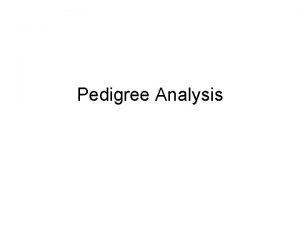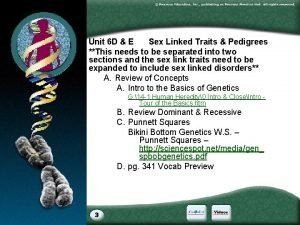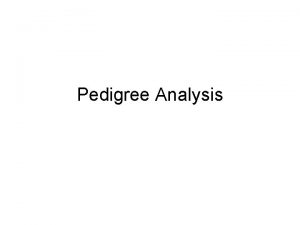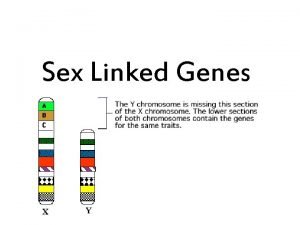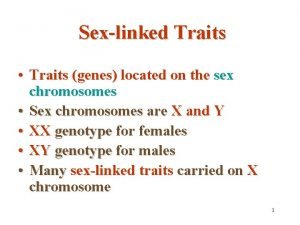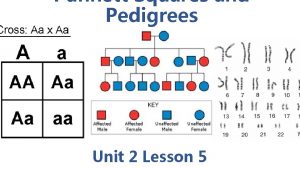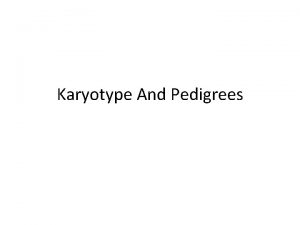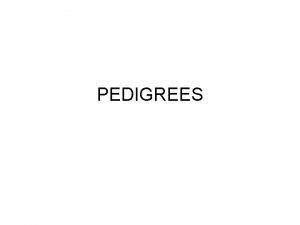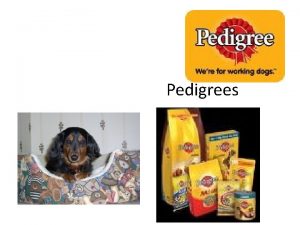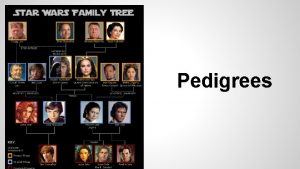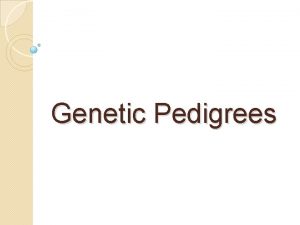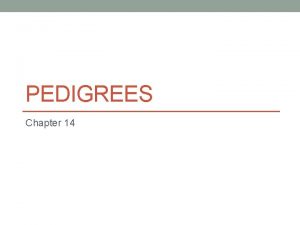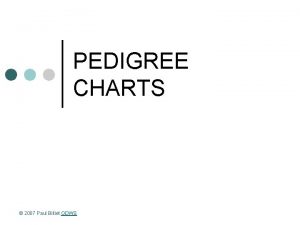Pedigrees and Sex Linked Traits Pedigree sex linked


















- Slides: 18

Pedigrees and Sex Linked Traits

Pedigree/ sex linked traits outline I. Pedigree circle= square = shaded= unshaded= half shaded = horizontal lines= vertical lines= roman numeral= Autosomes III. Sex chromosomes IV. Karyotype V. sex-linked traits II. more common in: why: diseases: examples of crosses

n Family Tree—traces a family name and family members through successive generations

n Pedigree—a graphic representation of genetic inheritance – helps identify sex of individual, individuals who are affected by a trait, and family relationships

n In a Pedigree… – Circle—Female – Square—Male

n Shaded circles and squares—individuals showing the trait being studied in pedigree n Unshaded circles and squares—individuals who do not show the trait being studied n Half-shaded circle or square—represents a carrier (heterozygous individual)

n Horizontal line— connects parents n Vertical line—connects parents to offspring n Roman numeral— shows generations Arabic numbers (1, 2, 3, etc…)—shows individuals n Rows= generations n

n Recessive trait—in a pedigree the trait appears to skip a generation n Individuals I 1 and I 2 —both must be carriers of the trait, because they have an offspring with the trait

n Individual II 1— probably not a carrier because no one in generation III has the trait n Individuals III 3 and III 4—both carriers because 2 individuals in generation IV are affected for trait

n Dominant trait—In a pedigree the trait usually appears in every generation – Remember—with a dominant trait, individuals only need to be heterozygous to be affected

n Individual I 2— heterozygous, because not all offspring are affected n Individual II 4— heterozygous because none of the offspring are affected

n Autosomes— 1 st 22 pairs of chromosomes in a human (all chromosomes that are not sex ones) n Sex chromosomes--23 rd (last) pair of chromosomes – Ex. XX-female XY-male • The male always determines sex of offspring

22 Autosomes Sex chromosomes

�Karyotype: chart showing all pairs of chromosomes in a human, used to show chromosomal disorders How would this karyotype look if the individual had trisomy 21? There would by 3 copies of chromosome 21

n Sex-linked traits--traits located on sex chromosomes (XX = female, XY = male

Sex linked disorders n More common in males because if carried on X chromosome, males only have one copy, if they receive bad copy, they have the disorder n Since females have 2 X’s, if they receive one bad copy, there’s still a chance of having a normal X cover it n Ex. color blindness, hemophilia

n Cross normal male and heterozygous female N = normal vision n = colorblind XN Y XN X NX N X NY Xn X NX n X n. Y Phenotypic ratio--Female: 100% normal (50% carriers) Male: 50% normal 50% colorblind

n Cross normal male and hemophiliac female H = normal blood h = hemophiliac XH Y Xh X HX h X h. Y Phenotypic ratio--Female: 100% normal (50% carriers) Male: 100% hemophiliac
 How to identify sex-linked traits from pedigree
How to identify sex-linked traits from pedigree Sex linked pedigree
Sex linked pedigree Pedigree sumbols
Pedigree sumbols Sex linkage punnett square
Sex linkage punnett square Sex linked traits
Sex linked traits Sex determination and sex linkage
Sex determination and sex linkage A and b punnett square
A and b punnett square Is breast cancer autosomal or sexlinked
Is breast cancer autosomal or sexlinked Kurt bumby
Kurt bumby Sex sex sex
Sex sex sex Xxtesticles
Xxtesticles Sex sex sex
Sex sex sex Sex sex sex
Sex sex sex Color blindness pedigree
Color blindness pedigree Pedigrees and karyotypes
Pedigrees and karyotypes Pedigrees and karyotypes
Pedigrees and karyotypes Pedigrees and karyotypes
Pedigrees and karyotypes Pedigrees edpuzzle
Pedigrees edpuzzle Pedigrees practice ap biology
Pedigrees practice ap biology
